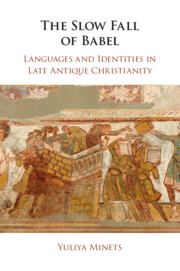Book contents
- The Slow Fall of Babel
- The Slow Fall of Babel
- Copyright page
- Dedication
- Contents
- Abbreviations
- Acknowledgments
- Introduction: Awakening to Linguistic Otherness
- Chapter 1 Meeting the Alloglottic Other: The Socio-Linguistic Landscape of the Ancient Mediterranean and the Spread of Christianity
- Chapter 2 Languages and Identities in Greco-Roman and Jewish Antiquity
- Chapter 3 The Tower of Babel and Beyond: The Primordial Linguistic Situation, the Original Language, and the Start of Linguistic Diversification
- Chapter 4 Speaking in Tongues in Christian Late Antiquity
- Chapter 5 Foreign Languages and the Discourse of Otherness
- Chapter 6 The Languages of Saints and Demons
- Conclusion: What’s in the Language?
- Bibliography
- Index
Conclusion: What’s in the Language?
Published online by Cambridge University Press: 02 December 2021
- The Slow Fall of Babel
- The Slow Fall of Babel
- Copyright page
- Dedication
- Contents
- Abbreviations
- Acknowledgments
- Introduction: Awakening to Linguistic Otherness
- Chapter 1 Meeting the Alloglottic Other: The Socio-Linguistic Landscape of the Ancient Mediterranean and the Spread of Christianity
- Chapter 2 Languages and Identities in Greco-Roman and Jewish Antiquity
- Chapter 3 The Tower of Babel and Beyond: The Primordial Linguistic Situation, the Original Language, and the Start of Linguistic Diversification
- Chapter 4 Speaking in Tongues in Christian Late Antiquity
- Chapter 5 Foreign Languages and the Discourse of Otherness
- Chapter 6 The Languages of Saints and Demons
- Conclusion: What’s in the Language?
- Bibliography
- Index
Summary
The book’s concluding chapter summarizes its content and contextualizes the ideas in a broader historical and cultural perspective. It is the story about the transformation of the ways in which the increasingly Christianized elites of the late antique Mediterranean experienced and conceptualized linguistic differences. Confessional and linguistic identities of the time overlapped in ways that produced an astonishing variety of dynamic combinations, hybrid loyalties, and local peculiarities. The chapter raises the question of what we do with language when we speak and how references to a linguistic code through which communication happens can be no less informative than the content of communication itself. It problematizes the concept of “other languages” and different ways in which different cultures, including early Christianity, imagine their principal alloglottic Other. We introduce the concept of “communities of linguistic sensitivities” – a group that share similar language-related socio-cultural stereotypes and subscribe to approximately the same views and ideas about linguistic history and linguistic diversity. The history of Christianity in Late Antiquity could be described in terms of the formation of several such related communities around the Mediterranean – communities that developed dynamically, constantly readjusted, and mutually influenced each other.
Keywords
- Type
- Chapter
- Information
- The Slow Fall of BabelLanguages and Identities in Late Antique Christianity, pp. 324 - 347Publisher: Cambridge University PressPrint publication year: 2021

